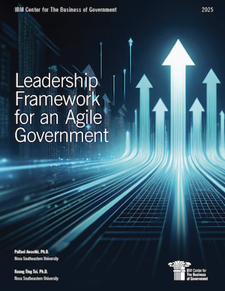
Harnessing Agility in Governance: A Leadership Framework for an Agile Government

Agile government, characterized by flexibility, adaptability, and responsiveness, has emerged as a compelling strategy for achieving success amidst complex and rapid change in the public sector. However, transitioning to such a model necessitates a shift in leadership paradigms.
A new report from the IBM Center for the Business of Government, Leadership Framework for an Agile Government, authored by Pallavi Awasthi and Kuang Ting Tai of Nova Southeastern University, offers valuable insights on this approach to transformation. The report provides a comprehensive exploration of leadership imperatives necessary for driving agile government, based on extensive research and case studies from digital leaders in city governments that include Boston, Philadelphia, Louisville, and Miami.
Understanding the Agile Leadership Paradigm
The report underscores the significance of adopting new, flexible, and participatory forms of leadership that can adapt over time. The authors identify six key themes for government leaders to facilitate agile approaches:
- Leadership Principles for an Agile Government: Successful government leaders in a digital context are constituent-centered, team-centered, adaptable. They encourage experimentation, maintain rhythm in project cycles, and are mission-driven to consistently progress towards desired outcomes.
- Leadership Models Incorporating Agile Characteristics: Three leadership models—Servant, Transformational, and Collaborative —have proven valuable for managing in an agile government environment. Servant leadership embodies empathy to understand team and constituent needs; Transformational leadership enables influencing and empowering teams; and Collaborative leadership fosters synergy across agencies.
- Competencies for Leadership in an Agile Government: Effective leadership in an agile government requires a multilevel approach. These levels range from individual-level competencies that include essential personal traits of leaders, to community-level competencies that involve interventions to understand community needs and capabilities.
- Leadership Training and Development Program for Agile Government: A robust leadership development and training program is crucial. This program should cover Servant, Transformational, and Collaborative leadership approaches, as well as workshops focused on enhancing specific skills.
- Leadership Best Practices for an Agile Government: Best practices include community engagement, digital commitment, innovation funding, digital engagement for all, and knowledge-sharing. These practices ensure a community-centric approach, digital ownership, dedicated innovation funding, community empowerment, and intergovernmental knowledge transfer.
- Barriers to Leadership in Implementing Agile Practices in Government: Transitioning to an agile government faces challenges. Barriers include leadership and cultural resistance, organizational structural rigidity, skill gaps, communication challenges, regulatory constraints, and difficulties in measuring performance. Overcoming these barriers requires a deep understanding and commitment to agile principles among leaders.
The report can help government leaders and stakeholders seeking to develop leaders capable of delivering agile government. By embracing these principles, competencies, and best practices, government agencies can become more agile -- enhancing service delivery, fostering innovation, and improving responsiveness to citizens' needs.
The complexity of moving to an agile government is requires a fundamental shift in leadership mindset and practices. However, the potential benefits - improved efficiency, enhanced citizen satisfaction, and increased adaptability - make this an objective worth pursuing. The report provides a solid foundation and roadmap for this transformative journey, in which agile leadership will be key to unlocking the full potential of digital transformation in the public sector.



